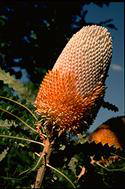In Flower This Week
A news sheet prepared by a Gardens' volunteer.
Numbers before each plant refer to temporary IFTW labels in the gardens.
Numbers in square brackets [ ] refer to garden bed Sections. Plants in flower are in bold type.
View past issues of 'In Flower This Week'.
18 March 2015
Banksia prionotes click for larger image |
Today we will concentrate on finding banksias in flower.
- Banksia prionotes [Section 174] on the right-hand side in a pot is showing toothed grey-green foliage and white felty cones which develop a pale orange colour when mature.
- Cross the bridge and skirt in front of the café. On the left is Banksia ‘Stumpy Gold’ [Section 131], a neat low bush with fine, toothed linear foliage and short golden cones. This plant is a dwarf cultivar of Banksia spinulosa var. collina that was selected by Richard Anderson of Merricks Nursery in Victoria.
- Also on your left is Banksia integrifolia [Section 131], a small tree with oblong green silver-backed leaves and greenish cones.
- Banksia spinulosa var. collina [Section 131] on the left has fine linear foliage and slender, dull gold cones.
- Veer left up the hill on the Main Path to see Banksia ericifolia subsp. ericifolia [Section 30] on your left, a long-flowering, medium-sized shrub with attractive divided foliage and long orange inflorescences. It is native to New South Wales, but has naturalised in small numbers in Victoria.
- On your right is Banksia heliantha [Section 30], which used to be known as Oak-leaved Dryandra before the reclassification of all dryandras to banksias. It has stiff spiky foliage and a magnificent lime green immature flower head erupting from a ring of deep red bracts.
- On your left is Banksia spinulosa ‘Birthday Candles’ [Section 30], a dense bright green bush with attractive needle foliage and short yellow cones with rusty red styles. ‘Birthday Candles’ is a dwarf cultivar of Banksia spinulosa var. spinulosa developed by Bill Molyneux of Austraflora Nurseries in Montrose, Victoria.
- On the right is Banksia spinulosa ‘Honeypots’ [Section 30], a small bush with fine-toothed foliage and chunky orange cones with red styles.
- Also on the right is Banksia integrifolia subsp. integrifolia [Section 30], or Coast Banksia, a small tree with yellow cones with grey tips.
- Banksia integrifolia subsp. integrifolia prostrate form [Section 30] is a vigorous groundcover with dark green leaves with silver backs. There are upright yellow-green cones on this versatile and hardy plant, which is native to coastal eastern Australia.
- On the left is Banksia spinulosa var. neoanglica [Section 30], or New England Banksia, with silver-backed dark green foliage with yellow/gold cones held upright. It is a shrub that grows along the east coast of Queensland and New South Wales.
- Banksia conferta var. pencillata [Section 25] or Newnes Plateau Banksia, also on the left, is a small tree covered in upward-pointing leaves. The green cones have grey ends to the flowers when mature, and a velvety brown “nose” protruding from the top.
- Also on your right is Banksia spinulosa [Section 27], a medium-sized bush with large pale yellow cones held upright on toothed linear grey-green foliage. Sometimes known as the Hairpin Banksia, it is native to the three eastern states and extends along the coast from Victoria to Cairns in Queensland.
- On the left is Banksia ericifolia ‘Red Clusters’ [Section 25], with heath-like foliage and very large red cones.
- Turn left back along the road to see on your right Banksia aemula [Section 24], or Wallum Banksia, a small gnarled tree with knobby bark and very large squat green cones. This plant can be found in Queensland and New South Wales from Bundaberg to Sydney, in coastal heaths on sandy soils.
Rosalind Walcott
![Director of National Parks [logo]](../../../../images/dnp_90px.gif)







